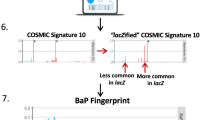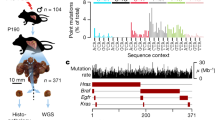Abstract
Observations from various biological systems suggest that chemical carcinogens transform cells by causing somatic mutations through interacting with DNA1–5. These observations raise several fundamental questions regarding the nature of the transforming genes that are the target of the carcinogens. For example, are there unique target gene(s) for chemical carcinogens, or are there multiple potential targets, any of which, when altered, can induce the transformed phenotype? This problem has been approached previously by comparing the rate of transformation by chemical carcinogens with the rate of appearance of dominant mutations in unique cellular genes encoding selectable markers. The results suggested a limited number of targets for transformation, since transformation occurred at a rate that was only 10–100 times greater than the appearance of ouabain-resistant mutants6–8. These results, however, are only rough estimates, because the optimal conditions for induction of transformation and the induction of mutations are known to differ6. In addition, lesions other than point mutations caused by carcinogens, such as frame-shifts, may induce transformation efficiency but not ouabain resistance. We now present an alternative experimental approach to estimating the number of targets for chemical carcinogens, based on the fact that DNAs of certain chemically transformed cell lines can induce the appearance of foci when transferred on to NIH3T3 cells9. These DNAs were treated with a variety of restriction endonucleases before testing their transforming activities by DNA transfer. We have found the same pattern of sensitivity and resistance to inactivation by different endonucleases in all DNAs studied, suggesting that the same transforming gene is being transferred in all cases.
This is a preview of subscription content, access via your institution
Access options
Subscribe to this journal
Receive 51 print issues and online access
$199.00 per year
only $3.90 per issue
Buy this article
- Purchase on Springer Link
- Instant access to full article PDF
Prices may be subject to local taxes which are calculated during checkout
Similar content being viewed by others
References
McCann, J., Choi, E., Yamasaki, E. & Ames, B. N. Proc. natn. Acad. Sci. U.S.A. 72, 5135–5139 (1975).
McCann, J. & Ames, B. N. Proc. natn. Acad. Sci. U.S.A. 73, 950–954 (1976).
Bridges, B. A. Nature 261, 195–200 (1976).
Bouck, N. & diMayorca, G. Nature 264, 722–727 (1976).
Barrett, J. C., Tsutsui, T. & Ts'o, P. O. P. Nature 274, 229–232 (1978).
Landolph, J. R. & Heidelberger, C. Proc. natn. Acad. Sci. U.S.A. 76, 930–934 (1979).
Parodi, S. & Brambilla, G. Mutat. Res. 47, 53–74 (1977).
Huberman, E., Mager, R. & Sachs, L. Nature 264, 360–361 (1976).
Shih, C., Shilo, B., Goldfarb, M. P., Dannenberg, A. & Weinberg, R. A. Proc. natn. Acad. Sci. U.S.A. 76, 5714–5718 (1979).
Shilo, B. et al. 12th Miami Winter Symp. (in the press).
Cooper, G. M., Okenquist, S. & Silverman, L. Nature 284, 418–421 (1980).
Shih, C., Padhy, L. C., Murray, M. & Weinberg, R.A. (in preparation).
Andersson, P., Goldfarb, M. P. & Weinberg, R. A. Cell 16, 63–75 (1979).
Canaani, E., Robbins, K. C. & Aaronson, S. A. Nature 282, 378–383 (1979).
Oskarsson, M., McClements, W. L., Blair, D. G., Maizel, J. V. & Vande Woude, G. F. Science 207, 1222–1224 (1980).
Ellis, R. W. et al. J. Virol. 35, 79–92 (1980).
Reznikoff, C. A., Bertram, J. S., Brankow, D. W. & Heidelberger, C. Cancer Res. 33, 3239–3249 (1973).
Rapp, U. R., Nowinski, R. C., Reznikoff, C. A. & Heidelberger, C. Virology 65, 392–409 (1975).
Benveniste, R. E., Todaro, G. J., Scolnick, E. M. & Parks, W. P. J. Virol. 12, 711–720 (1973).
Author information
Authors and Affiliations
Rights and permissions
About this article
Cite this article
Shilo, BZ., Weinberg, R. Unique transforming gene in carcinogen-transformed mouse cells. Nature 289, 607–609 (1981). https://doi.org/10.1038/289607a0
Received:
Accepted:
Issue Date:
DOI: https://doi.org/10.1038/289607a0
This article is cited by
-
Milestones in Skin Carcinogenesis: The Biology of Multistage Carcinogenesis
Journal of Investigative Dermatology (2014)
-
Molecular mechanisms of acquired resistance to tyrosine kinase targeted therapy
Molecular Cancer (2010)
-
Synthesis and Catalytic Reactivity of MCM-22/ZSM-35 Composites for Olefin Aromatization
Catalysis Letters (2005)
-
Selection of transfored cells in serum-free media
In Vitro Cellular & Developmental Biology (1985)
Comments
By submitting a comment you agree to abide by our Terms and Community Guidelines. If you find something abusive or that does not comply with our terms or guidelines please flag it as inappropriate.



